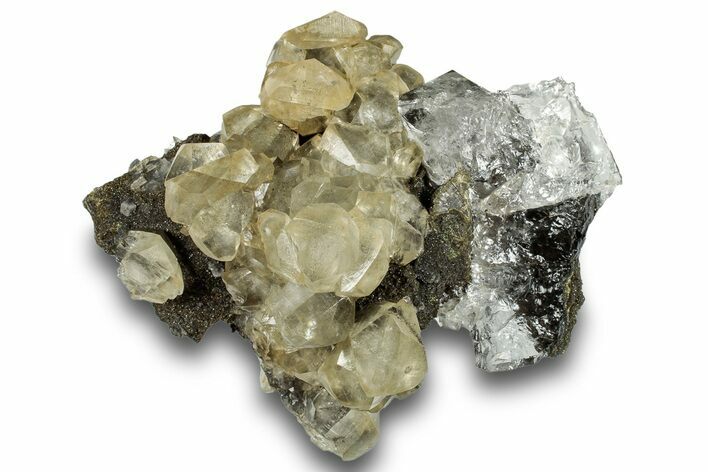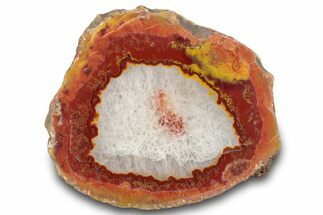This Specimen has been sold.
3.9" Calcite Crystals with Dolomite and Herkimer Diamonds - New York
This is a beautiful, 3.9" wide specimen featuring calcite crystals that formed from a dolomite and druzy pyrite crystal encrusted matrix. It comes out of the Benchmark Quarry in Montgomery County, New York. Benchmark Quarry is one of several sites known to produce "Herkimer diamonds" which can be found along one edge of this specimen.
It comes with an acrylic display stand.
It comes with an acrylic display stand.
About Herkimer Diamonds
Herkimer Diamonds are not actual diamonds, but rather double-terminated quartz crystals found in and around Herkimer County, New York. The term "diamond" refers not only to their exceptional clarity but also to the natural facets they display when found. Only crystals with these qualities that are found in Herkimer County can be officially called Herkimer Diamonds. Similar double-terminated quartz crystals have been discovered in abundance in Tibet and Afghanistan, but these are not considered true Herkimer Diamonds.
The geologic history of these crystals began around 495 million years ago in a shallow sea. Waxy organic material, along with quartz sand and pyrite, became encased in rock composed of dolomite and calcite. As the sediment buried the rock and temperatures rose, crystals formed very slowly, resulting in quartz with exceptional clarity. Inclusions within these crystals provide clues to their origin—ranging from solids, liquids (such as saltwater or petroleum), and gases (most often carbon dioxide) to two- and three-phase inclusions and negative (uniaxial) crystals.
Herkimer Diamonds are not actual diamonds, but rather double-terminated quartz crystals found in and around Herkimer County, New York. The term "diamond" refers not only to their exceptional clarity but also to the natural facets they display when found. Only crystals with these qualities that are found in Herkimer County can be officially called Herkimer Diamonds. Similar double-terminated quartz crystals have been discovered in abundance in Tibet and Afghanistan, but these are not considered true Herkimer Diamonds.
The geologic history of these crystals began around 495 million years ago in a shallow sea. Waxy organic material, along with quartz sand and pyrite, became encased in rock composed of dolomite and calcite. As the sediment buried the rock and temperatures rose, crystals formed very slowly, resulting in quartz with exceptional clarity. Inclusions within these crystals provide clues to their origin—ranging from solids, liquids (such as saltwater or petroleum), and gases (most often carbon dioxide) to two- and three-phase inclusions and negative (uniaxial) crystals.
About Calcite Crystals
Calcite crystals are a form of calcium carbonate (CaCO₃) known for their diverse shapes, transparency, and vibrant range of colors. They typically form in rhombohedral, scalenohedral, or prismatic shapes, often with well-defined, sharp edges and glossy surfaces. Calcite crystals are often translucent or transparent, sometimes displaying a double refraction effect where objects viewed through the crystal appear doubled. They can appear in various colors—white, clear, yellow, pink, blue, green, and orange—depending on impurities or trace minerals.
A notable characteristic of calcite is its reaction with weak acids like vinegar, which causes it to effervesce, or fizz, as it releases carbon dioxide. This property makes calcite crystals a key tool in geological identification and studies. Calcite forms in many environments, from sedimentary rocks like limestone and marble to hydrothermal veins.
Calcite crystals are a form of calcium carbonate (CaCO₃) known for their diverse shapes, transparency, and vibrant range of colors. They typically form in rhombohedral, scalenohedral, or prismatic shapes, often with well-defined, sharp edges and glossy surfaces. Calcite crystals are often translucent or transparent, sometimes displaying a double refraction effect where objects viewed through the crystal appear doubled. They can appear in various colors—white, clear, yellow, pink, blue, green, and orange—depending on impurities or trace minerals.
A notable characteristic of calcite is its reaction with weak acids like vinegar, which causes it to effervesce, or fizz, as it releases carbon dioxide. This property makes calcite crystals a key tool in geological identification and studies. Calcite forms in many environments, from sedimentary rocks like limestone and marble to hydrothermal veins.
SPECIES
Calcite, Dolomite, Quartz & Pyrite
LOCATION
Benchmark Quarry, St Johnsville, Montgomery County, New York
SIZE
Specimen: 3.9 x 3.2"
CATEGORY
ITEM
#251202
 Reviews
Reviews














